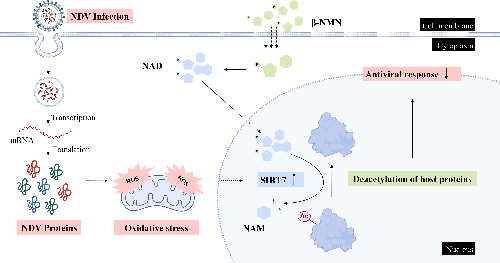
Full text loading...


Reactive oxygen species (ROS) accumulation inside the cells instigates oxidative stress, activating stress-responsive genes. The viral strategies for promoting stressful conditions and utilizing the induced host proteins to enhance their replication remain elusive. The present work investigates the impact of oxidative stress responses on Newcastle disease virus (NDV) pathogenesis. Here, we show that the progression of NDV infection varies with intracellular ROS levels. Additionally, the results demonstrate that NDV infection modulates the expression of oxidative stress-responsive genes, majorly sirtuin 7 (SIRT7), a NAD+-dependent deacetylase. The modulation of SIRT7 protein, both through overexpression and knockdown, significantly impacts the replication dynamics of NDV in DF-1 cells. The activation of SIRT7 is found to be associated with the positive regulation of cellular protein deacetylation. Lastly, the results suggested that NDV-driven SIRT7 alters NAD+ metabolism in vitro and in ovo. We concluded that the elevated expression of NDV-mediated SIRT7 protein with enhanced activity metabolizes the NAD+ to deacetylase the host proteins, thus contributing to high virus replication.

Article metrics loading...

Full text loading...
References


Data & Media loading...
Supplements
